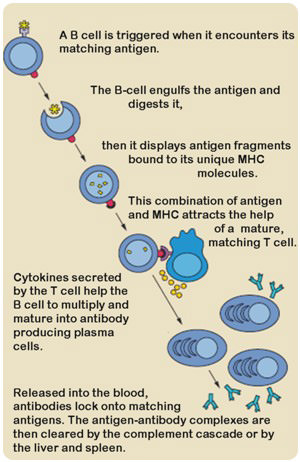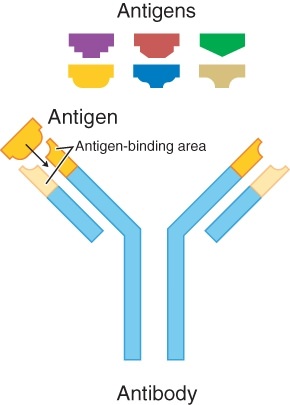13.42: Respuesta humoral
- Page ID
- 108486
\( \newcommand{\vecs}[1]{\overset { \scriptstyle \rightharpoonup} {\mathbf{#1}} } \)
\( \newcommand{\vecd}[1]{\overset{-\!-\!\rightharpoonup}{\vphantom{a}\smash {#1}}} \)
\( \newcommand{\dsum}{\displaystyle\sum\limits} \)
\( \newcommand{\dint}{\displaystyle\int\limits} \)
\( \newcommand{\dlim}{\displaystyle\lim\limits} \)
\( \newcommand{\id}{\mathrm{id}}\) \( \newcommand{\Span}{\mathrm{span}}\)
( \newcommand{\kernel}{\mathrm{null}\,}\) \( \newcommand{\range}{\mathrm{range}\,}\)
\( \newcommand{\RealPart}{\mathrm{Re}}\) \( \newcommand{\ImaginaryPart}{\mathrm{Im}}\)
\( \newcommand{\Argument}{\mathrm{Arg}}\) \( \newcommand{\norm}[1]{\| #1 \|}\)
\( \newcommand{\inner}[2]{\langle #1, #2 \rangle}\)
\( \newcommand{\Span}{\mathrm{span}}\)
\( \newcommand{\id}{\mathrm{id}}\)
\( \newcommand{\Span}{\mathrm{span}}\)
\( \newcommand{\kernel}{\mathrm{null}\,}\)
\( \newcommand{\range}{\mathrm{range}\,}\)
\( \newcommand{\RealPart}{\mathrm{Re}}\)
\( \newcommand{\ImaginaryPart}{\mathrm{Im}}\)
\( \newcommand{\Argument}{\mathrm{Arg}}\)
\( \newcommand{\norm}[1]{\| #1 \|}\)
\( \newcommand{\inner}[2]{\langle #1, #2 \rangle}\)
\( \newcommand{\Span}{\mathrm{span}}\) \( \newcommand{\AA}{\unicode[.8,0]{x212B}}\)
\( \newcommand{\vectorA}[1]{\vec{#1}} % arrow\)
\( \newcommand{\vectorAt}[1]{\vec{\text{#1}}} % arrow\)
\( \newcommand{\vectorB}[1]{\overset { \scriptstyle \rightharpoonup} {\mathbf{#1}} } \)
\( \newcommand{\vectorC}[1]{\textbf{#1}} \)
\( \newcommand{\vectorD}[1]{\overrightarrow{#1}} \)
\( \newcommand{\vectorDt}[1]{\overrightarrow{\text{#1}}} \)
\( \newcommand{\vectE}[1]{\overset{-\!-\!\rightharpoonup}{\vphantom{a}\smash{\mathbf {#1}}}} \)
\( \newcommand{\vecs}[1]{\overset { \scriptstyle \rightharpoonup} {\mathbf{#1}} } \)
\( \newcommand{\vecd}[1]{\overset{-\!-\!\rightharpoonup}{\vphantom{a}\smash {#1}}} \)
\(\newcommand{\avec}{\mathbf a}\) \(\newcommand{\bvec}{\mathbf b}\) \(\newcommand{\cvec}{\mathbf c}\) \(\newcommand{\dvec}{\mathbf d}\) \(\newcommand{\dtil}{\widetilde{\mathbf d}}\) \(\newcommand{\evec}{\mathbf e}\) \(\newcommand{\fvec}{\mathbf f}\) \(\newcommand{\nvec}{\mathbf n}\) \(\newcommand{\pvec}{\mathbf p}\) \(\newcommand{\qvec}{\mathbf q}\) \(\newcommand{\svec}{\mathbf s}\) \(\newcommand{\tvec}{\mathbf t}\) \(\newcommand{\uvec}{\mathbf u}\) \(\newcommand{\vvec}{\mathbf v}\) \(\newcommand{\wvec}{\mathbf w}\) \(\newcommand{\xvec}{\mathbf x}\) \(\newcommand{\yvec}{\mathbf y}\) \(\newcommand{\zvec}{\mathbf z}\) \(\newcommand{\rvec}{\mathbf r}\) \(\newcommand{\mvec}{\mathbf m}\) \(\newcommand{\zerovec}{\mathbf 0}\) \(\newcommand{\onevec}{\mathbf 1}\) \(\newcommand{\real}{\mathbb R}\) \(\newcommand{\twovec}[2]{\left[\begin{array}{r}#1 \\ #2 \end{array}\right]}\) \(\newcommand{\ctwovec}[2]{\left[\begin{array}{c}#1 \\ #2 \end{array}\right]}\) \(\newcommand{\threevec}[3]{\left[\begin{array}{r}#1 \\ #2 \\ #3 \end{array}\right]}\) \(\newcommand{\cthreevec}[3]{\left[\begin{array}{c}#1 \\ #2 \\ #3 \end{array}\right]}\) \(\newcommand{\fourvec}[4]{\left[\begin{array}{r}#1 \\ #2 \\ #3 \\ #4 \end{array}\right]}\) \(\newcommand{\cfourvec}[4]{\left[\begin{array}{c}#1 \\ #2 \\ #3 \\ #4 \end{array}\right]}\) \(\newcommand{\fivevec}[5]{\left[\begin{array}{r}#1 \\ #2 \\ #3 \\ #4 \\ #5 \\ \end{array}\right]}\) \(\newcommand{\cfivevec}[5]{\left[\begin{array}{c}#1 \\ #2 \\ #3 \\ #4 \\ #5 \\ \end{array}\right]}\) \(\newcommand{\mattwo}[4]{\left[\begin{array}{rr}#1 \amp #2 \\ #3 \amp #4 \\ \end{array}\right]}\) \(\newcommand{\laspan}[1]{\text{Span}\{#1\}}\) \(\newcommand{\bcal}{\cal B}\) \(\newcommand{\ccal}{\cal C}\) \(\newcommand{\scal}{\cal S}\) \(\newcommand{\wcal}{\cal W}\) \(\newcommand{\ecal}{\cal E}\) \(\newcommand{\coords}[2]{\left\{#1\right\}_{#2}}\) \(\newcommand{\gray}[1]{\color{gray}{#1}}\) \(\newcommand{\lgray}[1]{\color{lightgray}{#1}}\) \(\newcommand{\rank}{\operatorname{rank}}\) \(\newcommand{\row}{\text{Row}}\) \(\newcommand{\col}{\text{Col}}\) \(\renewcommand{\row}{\text{Row}}\) \(\newcommand{\nul}{\text{Nul}}\) \(\newcommand{\var}{\text{Var}}\) \(\newcommand{\corr}{\text{corr}}\) \(\newcommand{\len}[1]{\left|#1\right|}\) \(\newcommand{\bbar}{\overline{\bvec}}\) \(\newcommand{\bhat}{\widehat{\bvec}}\) \(\newcommand{\bperp}{\bvec^\perp}\) \(\newcommand{\xhat}{\widehat{\xvec}}\) \(\newcommand{\vhat}{\widehat{\vvec}}\) \(\newcommand{\uhat}{\widehat{\uvec}}\) \(\newcommand{\what}{\widehat{\wvec}}\) \(\newcommand{\Sighat}{\widehat{\Sigma}}\) \(\newcommand{\lt}{<}\) \(\newcommand{\gt}{>}\) \(\newcommand{\amp}{&}\) \(\definecolor{fillinmathshade}{gray}{0.9}\)
¿Qué son esas cosas en forma de Y flotando alrededor de la celda?
Son anticuerpos, que son proteínas grandes. Y señalan antígenos específicos para su destrucción. Ayuda que los antígenos suelen estar unidos a patógenos.
Respuesta inmune humoral
En realidad hay dos tipos de respuestas inmunes: humoral y mediada por células. La respuesta inmune humoral involucra principalmente a las células B y tiene lugar en la sangre y la linfa.
Activación de células B
Las células B deben ser activadas por un antígeno antes de que puedan combatir patógenos. Esto sucede en la secuencia de eventos que se muestra en la Figura a continuación. Primero, una célula B encuentra su antígeno coincidente y lo envuelve. La célula B luego muestra fragmentos del antígeno en su superficie. Esto atrae a una célula T auxiliar. La célula T auxiliar se une a la célula B en el sitio del antígeno y libera citocinas que “dicen” o señalan a la célula B que se desarrolle en una célula plasmática.
 La activación de una célula B debe ocurrir antes de que pueda responder a patógenos. ¿Qué papel juegan las células T en el proceso de activación?
La activación de una célula B debe ocurrir antes de que pueda responder a patógenos. ¿Qué papel juegan las células T en el proceso de activación? Células plasmáticas y producción de anticuerpos
Las células plasmáticas son células B activadas que secretan anticuerpos. Los anticuerpos son proteínas grandes en forma de Y que reconocen y se unen a antígenos. Las células plasmáticas son como fábricas de anticuerpos, produciendo muchas copias de un solo tipo de anticuerpo. Los anticuerpos viajan por todo el cuerpo en sangre y linfa. Cada anticuerpo se une a un solo tipo de antígeno. Cuando lo hace, forma un complejo antígeno-anticuerpo (ver Figura a continuación). El complejo marca la célula portadora de antígeno para su destrucción por fagocitosis.
 Un anticuerpo coincide solo con un tipo de antígeno.
Un anticuerpo coincide solo con un tipo de antígeno. Células de memoria
La mayoría de las células plasmáticas viven solo unos días, pero algunas de ellas viven mucho más tiempo. Incluso pueden sobrevivir durante toda la vida del individuo. Las células plasmáticas de larga vida se llaman células de memoria. Conservan un “recuerdo” de un patógeno específico mucho después de que una infección haya terminado. Ayudan a lanzar una respuesta rápida contra el patógeno si vuelve a invadir el cuerpo en el futuro.
Resumen
- Las células B activadas producen anticuerpos contra un antígeno particular.
- Las células B de memoria permanecen en el cuerpo después de que termina la respuesta inmune y proporcionan inmunidad a los patógenos que portan el antígeno.
Revisar
- ¿Cómo ayudan las células plasmáticas a combatir los patógenos? Incluya el papel de los anticuerpos en su respuesta.
- Si una enfermedad destruyó las células T auxiliares de una persona, ¿cómo podría afectar esto la capacidad de lanzar una respuesta inmune?
- ¿Qué son las celdas de memoria? ¿Cuál es su papel?
| Imagen | Referencia | Atribuciones |
 |
[Figura 1] | Crédito: Usuario:Fvasconcellos/Wikimedia Commons Fuente: commons.wikimedia.org/wiki/Archivo:Antibody.svg Licencia: CC BY-NC |
 |
[Figura 2] | Crédito: Cortesía de los Institutos Nacionales de la Salud y Usuario:do11.10/Wikimedia Commons Fuente: Commons.wikimedia.org/wiki/Archivo:b_cell_activation.png Licencia: Dominio público |
 |
[Figura 3] | Crédito: Usuario:Fvasconcellos/Wikimedia Commons Fuente: commons.wikimedia.org/wiki/Archivo:Antibody.svg Licencia: Dominio público |

